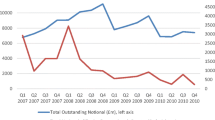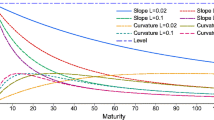Abstract
This paper uses a multi-factor latent variable model to examine the time variation of expected returns on Asian property stocks. Using data from 1990 to 1997, we found strong evidence of time-varying risk premium, suggesting property development based on constant discount rate may underestimate the cost of capital. A further study using a multi-country model suggests that conditional excess returns of many crisis-stricken economies appear to move quite closely with each other. This supports the hypothesis that the risk premiums in these Asian markets move closely over time As a result, they provide a partial explanation of market contagion in the region.
Similar content being viewed by others
References
Bekaert, G., and C. R. Harvey. (1995). “Time-Varying World Market Integration,” Journal of Finance 50(2), 403-444.
Bekaert, G., and C. R. Harvey. (1997). “Emerging Equity Market Volatility,” Journal of Financial Economics 43(1), 27-77.
Bessler, W., and G. Booth. (1994). “Interest Rate Sensitivity of Bank Stock Returns in a Universal Banking System,” Journal of International Financial Markets, Institutions and Money 3(3-4), 117-136.
Campbell, J., and Y. Hamao. (1992). “Predictable Returns in the United States and Japan a Study of Long-Term Capital Markets Integration,” Journal of Finance 47(1), 43-70.
Fama, E., and K. French. (1988). “Dividend Yields and Expected Stock Returns,” Journal of Financial Economics 22(1), 3-25.
Fama, E., and K. French. (1989). “Business Conditions and Expected Returns on Stocks and Bonds,” Journal of Financial Economics 25(1), 23-49.
Ferson, W. (1989). “Changes in Expected Security Returns, Risk and Level of Interest Rates,” Journal of Finance 44, 1191-1217.
Ferson, W. E., and C. R. Harvey. (1993). “The Risk and Predictability of International Equity Returns,” Review of Financial Studies 6(3), 527-566.
Gibbons, M., and W. Ferson. (1985). “Testing Asset Pricing Models with Changing Expectations and an Unobservable Market Portfolio,” Journal of Financial Economics 14(2), 217-236.
Ling, D., and A. Naranjo. (1997). “Economic Risk Factors and Commercial Real Estate Returns,” Journal of Real Estate Finance and Economics 14(3), 283-307.
Ling, D., and A. Naranjo. (1999). “The Integration of Commercial Real Estate Markets and Stock Markets,” Real Estate Economics 27(3), 483-515.
Liu, C., and J. Mei. (1998). “The Predictability of International Real Estate Markets, Exchange Rate Risks and Diversification Consequences,” Real Estate Economics 26(1), 3-39.
Harvey, C. (1995). “Predictable Risk and Returns in Emerging Markets,” Review of Financial Studies 773-816.
Krugman, P. (1998). Will Asia Bounce Back? Speech for CFFB, Hong Kong.
Malkiel, B., and J. P. Mei. (1998). Global Bargain Hunting, Simon and Schuster.
Rights and permissions
About this article
Cite this article
Mei, J.(.P., Hu, J. Conditional Risk Premiums of Asian Real Estate Stocks. The Journal of Real Estate Finance and Economics 21, 297–313 (2000). https://doi.org/10.1023/A:1012008004402
Issue Date:
DOI: https://doi.org/10.1023/A:1012008004402




